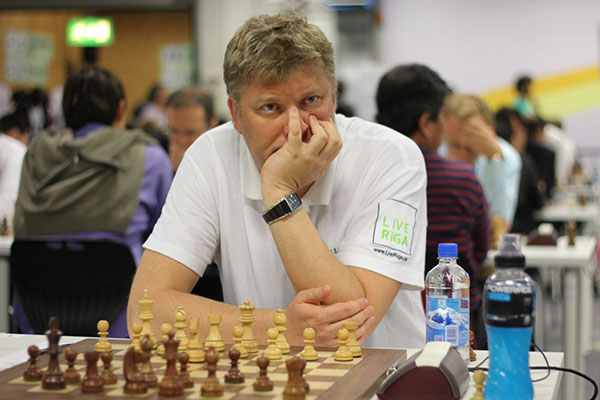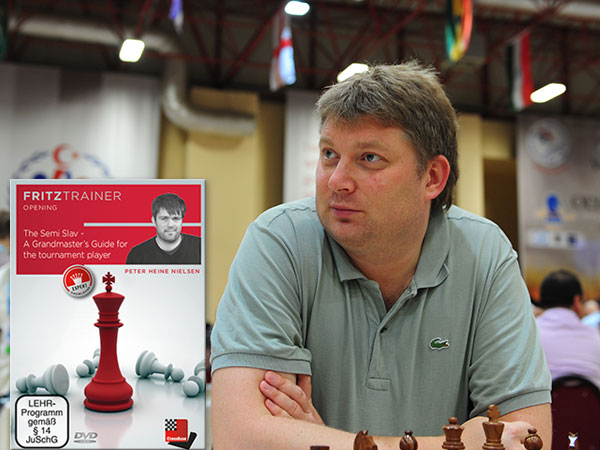...and suddenly you play against Shirov
In the evening of round four I looked at the pairings for the next day at the RTU Open in Riga and saw that I was to play Shirov. At the beginning of the tournament I did not play particularly well but after a relatively easy win in round four I felt for the first time that I had found my way into the tournament. And now Alexei Shirov, tactical genius and hero of my youth.

Alexei Shirov | Photo: Pascal Simon
Preparation
Usually I prepare in the morning, even if the rounds start early, but for this special opponent I opened my laptop in the evening. I had White and it should not be too difficult too guess the opening: it would be a Semi-Slav — a Meran, to be more precise.
Shirov has a rather narrow repertoire with Black but he is also considered to be one of the leading experts in the Semi-Slav. My own experience with this line has been rather limited: I tried the Semi-Slav a couple of times, many years ago, but my results were poor and I had discarded the line again. The games I had played with White in this line could also be counted on the fingers of one hand.
A lucky coincidence
However, a lucky coincidence cheered me up: Just before the tournament I had studied Peter-Heine Nielsen's DVD "The Semi-Slav". I knew Nielsen's two DVDs about the Dragon and to be honest, I had ordered his "Semi-Slav" more because I liked the author and less because I liked the opening.
Armed with Nielsen's analyses I start my preparation. On the sixth move White already has a big choice: The two main moves 6.Bd3 and 6.Qc2 both have advantages and disadvantages and Nielsen does not say which move is more dangerous for Black. However, when studying the DVD, I realized for the first time that the two moves often transpose leading to the same position.
In the past I have always tried to reach this position and Nielsen also thinks that this variation is one of the most exciting possibilities for White. Therefore, he dedicates a whole chapter to this position. In more than 27 minutes, he explains how this position has been played before and what the current state of theory is. Black has four options: 11...a5, 11...a6, 11...Qe7 and 11...Rc8.

Peter Heine Nielsen on the position after 11.a3
The main move is 11...Rc8. This move first seems to be wrong because the breakthrough ...c5 which Black definitely wants to play seems no longer to be possible after White's logical reply 12.b4. But in the game Topalov-Kazimdzhanov, GP London 2012, the FIDE-World Champion from 2004 uncorked the stunning 12...c5!!. Nielsen reveals that Topalov had already known about this move before the game but had hoped that this idea had escaped Kazimdzhanov.
In the stem game 12...c5 led to a quick draw and my preparation shows that Shirov has tried this idea no less than seven times. But I quickly dismiss the thought that Shirov will play 11...Rc8 against me because this line after all gives White the option of a safe draw.
Therefore I check the other possible moves for Black. In five games Shirov tried 11...a5 which forces a structure Nielsen considers to be very comfortable for White.

Nielsen about the structure resulting after 11...a5
The big drawback for Black is that his standard plan ...c5 is difficult to carry out after pushing ahead with ...a5: the b-pawn is simply too weak when Black no longer has the option to play ...a6.
To quote Nielsen: "Inserting the moves a3 and ...a5 is a serious disadvantage for Black's queenside."
11...a6 is the old main move and for a long time has been considered to be the critical line. What Nielsen has to say about this move is particularly interesting. After all, he has not been a silent observer of the developments in this line but had his share in developing the theory of this move. As a long-time second of former World Champion Vishy Anand he came up with many ideas in this line. The move 20...Ba1!! (which in 2008 helped Anand to a phantastic win against Gelfand) deserves particular attention.
The Semi-Slav (1.d4 d5 2.c4 c6 3.Nf3 Nf6 4.Nc3 e6) can arise via various move orders, has decided World Championships, and is one of Black's most fascinating replies to 1 d4. Magnus Carlsen's second, Grandmaster Peter Heine Nielsen explains in detail what this opening is all about.
On his DVD Nielsen reveals a number of possibilities to improve Gelfand's play. Though these sometimes might lead to crazy positions which are very much to Shirov's liking I am ready to test Nielsen's recommendations.
The main part of my preparation is dedicated to 11...Qe7. Shirov's only game in the database dates back to 1992 but I do have a feeling that this might be a winning attempt he could try. When writing this article I found out that Shirov chose exactly this line in the third round of the RTU Open. I had missed this game during my preparation. And my intuition was right though Shirov did not want to try this move again.
As Nielsen explains the obvious move here is 12.Ng5. But on a second glance that 11...Qe7 is directed exactly against this. After the logical sequence 12.Ng5 h6 13.Ne4 Nxe4 14.Nxe4, black has 14...c5! Black liberates his bishop on b7 and the activity of his pieces compensates for the loss of the bishop's pair. Incidentally, Shirov's third round game followed exactly this path.
However, the critical move is 12.e4! After the forced reply 12...e5 White has a choice between 13.Bg5 and 13.Ne2.
The knight move scores much better in practice and has been tried by players such as Boris Gelfand and Pavel Eljanov. But Nielsen thinks that black has nothing to fear in this line. According to him the direct Bg5 is stronger. Kasimdzhanov introduced this move into practice. Nielsen analyzes the critical lines and concludes that White has the more comfortable play.
The game
After my extensive preparation I start the following day confidently. I meet Alexei in the breakfast hall where he greets me cordially. "See you later" — all right.

The photo made during the game — though, admittedly, one does not see my better side | Photo: rtuopen.lv
Shirov rattles off the first moves. I am content because there are no surprises and we are heading towards the main position after 11.a3. Shirov plays 10...Bb7 à tempo and suddenly I have doubts. What does he want to do? The position is already in the database, and Shirov could assume that I would repeat this line. Did he dig something up? And how did these crazy complicated lines after 11...a6 work again? Even if I could remember everything, it seems to be naive to believe I could outprepare Shirov with the work of one single evening. By sitting in your hotel room and watching a DVD... I remember that I once analyzed the move 11.Ng5. Black has to reply with 11...h6 and after 12.Ne4 a couple of minor pieces vanish from the board. Black can equalize but is this line not the smarter choice against an opponent like Shirov? To soft-pedal and to play small ball?
I pull myself together again. A couple of weeks ago I played with white against Kiril Georgiev in the Greek League. I had lost two games before and my team was slowly drifting into the relegation zone. In that game I had decided to play it safe. Georgiev tortured me for 60 moves — not a nice experience even though the result was okay in the end. But I do not want to experience something like that against Shirov. Therefore 11.a3!
While I was pondering, Shirov got up from his chair to walk around in the playing hall. He comes back, completes his scoresheet and plays à tempo 11...Rc8. I really did not expect this move. I keep my cool and react with 12.b4. After 12...c5 there followed 13.bxc5 Bxf3 to which there are basically no alternatives.
Here White is at a crossroads. I know that Shirov has already drawn several games in this way. I try to remember the line and I am glad when this works quickly and without problems. I know that Nielsen recommends 14.cxd6 and says that this might well be the most critical line in the entire 11.a3-complex. I try to bring order to the lines: what follows is 14...Nd5 15.gxf3. Shirov lost a game with 15...Nxc3 against Radoslaw Wojtaszek and recently played the critical 15...Qg5+ against the Indian SP Sethuraman.
I remember that Nielsen mentioned a game by Etienne Bacrot but I have no clue how that went exactly. What to do? The fact is that Shirov despite two losses considers this line to be playable, and might have had another look at his analysis yesterday evening. I, however, only remember glimpses from Nielsen's DVD and I have never analyzed the variation seriously. Even if White somewhere had a way to get an advantage I would be mad to enter it. Therefore 14.gxf3.
Shirov does not seem surprised and we rattle off the moves. Black wins back the sacrificed piece and White has to find a couple of precise moves to finally force an equal rook ending. After 25.Rb7 Shirov smiles at me, shrugs his shoulders and asks "draw?" He knows the endgame, after all, he had it no less than four times on the board.
After the game
After the game Shirov seems to be in a relaxed and easy-going mood. "I thought you would play 11...Qe7", I tell him. "Mmh", is his reply. He admits that he does not at all like the lines after 13.Ne2 and thinks that the position is very dangerous for Black. Ah, that's interesting, after all, Nielsen sees the problems elsewhere.
I quickly return to the hotel, after all, the next round follows in the afternoon. Somehow I wanted to have a different game, a more exciting one. After all, it is not everyday that you have the chance to play against Shirov. And then you do not play a single move of your own? That's a pity! However, Arik [Braun], with whom I share the room, still congratulates me. A draw against Shirov would be a good result. And after all he had shown respect by accepting the draw instead of playing a dangerous position against me. My team colleague Ilja [Schneider] is not surprised: "Shirov is the kind of guy who strives for the truth", he philosophizes. "If the best line is a draw, it is a draw."
After the tournament I have another look at 11...Rc8. Probably you have to play the positions after 14.cxd6 and 15...Qg5+. The game by Bacrot is very convincing, however, his opponent helped a quite a lot. I do find an interesting game by Jan Gustafsson. Who was after all part of team-Carlsen during the 2016 World Championship match against Karjakin and really knows something about openings. Gustafsson also played 14.cxd6 and won. Then I discover the following: Anish Giri refrained in the Candidates Tournament 2016 against Sergey Karjakin from 12...c5 and instead played 12...a5.
But Giri no longer seems to trust 12...c5 entirely. However, by now Giri's move has found top-level followers: Boris Gelfand and Sam Sevian. Nielsen does not talk about his move but maybe this is the new battlefield in the Semi-Slav.
All the games mentioned in the article
Translation from German: Johannes Fischer
Links



























